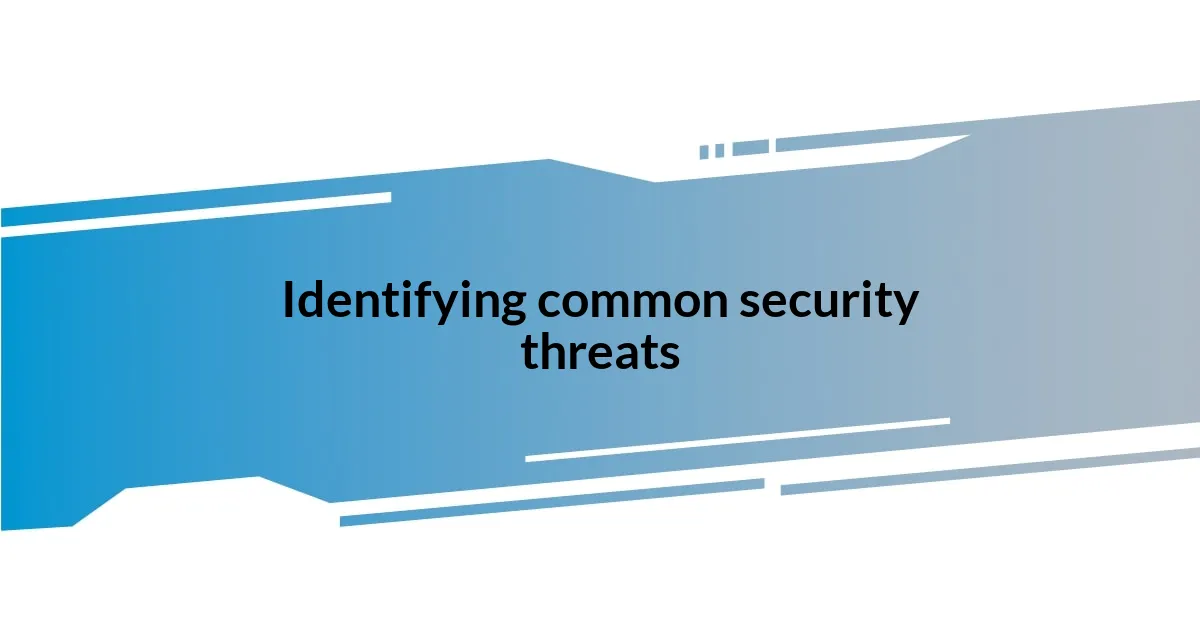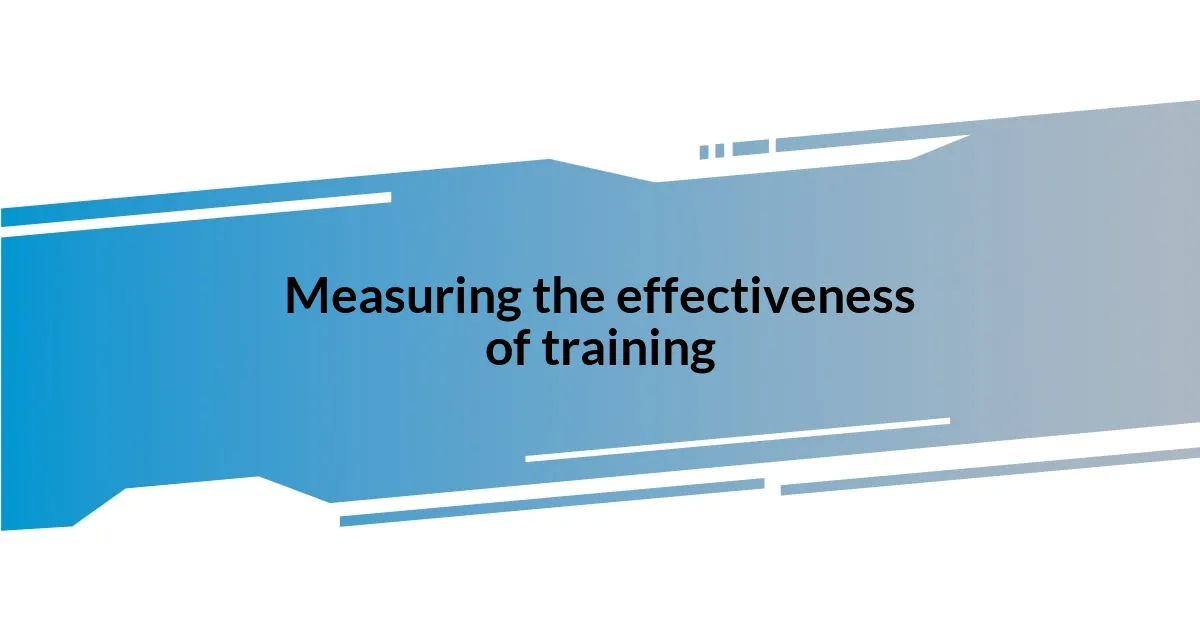Key takeaways:
- Creating a culture of vigilance and shared responsibility is essential for effective employee security awareness.
- Continuous training significantly enhances employees’ ability to recognize security threats and take proactive measures.
- Engaging training methods, such as gamification and storytelling, foster deeper connections and understanding of security practices.
- Regular feedback and discussions help identify gaps in training and improve security practices continuously.

Understanding employee security awareness
Understanding employee security awareness goes beyond just knowing the basic policies; it deeply involves creating a culture of vigilance. I recall a time when a colleague clicked on a suspicious link in an email, thinking it was harmless. The panic that ensued revealed the fragility of our security; suddenly, everyone was aware of how a single mistake could jeopardize the entire organization.
When employees recognize their role in security, it’s not merely a checklist to tick off—it’s a mindset shift. I often think about how empowering it feels to share knowledge during team meetings. When we discuss security risks as a team, I see a spark of responsibility ignite in my coworkers. This engagement reinforces the idea that security is a shared responsibility and not just a task relegated to IT.
Have you ever wondered if your employees truly grasp the importance of their actions in maintaining secure practices? From my experience, the answer often varies. Those who receive continuous training and open communication are far more alert and proactive against potential threats, fostered by an environment where asking questions is encouraged.

Importance of employee security training
The significance of employee security training cannot be overstated. Last year, I witnessed firsthand how a well-prepared team thwarted a phishing attempt because they could recognize warning signs. It was a proud moment for me, realizing that our regular training sessions genuinely helped increase awareness and confidence among the team.
It’s interesting to note how different levels of training impact employee behavior. I once worked with a department with minimal training, and the lack of awareness was alarming. They frequently fell victim to common threats, highlighting the necessity for every employee to receive ongoing education and updates on security practices.
Have you ever faced a situation where one trained employee saved the day? I certainly have. In a previous role, one of our interns spotted an abnormal email and alerted the team, preventing a possible data breach. This experience solidified my belief that investing in comprehensive security training not only protects the organization but also instills a sense of agency and responsibility in every employee.
| Aspect | Trained Employees | Untrained Employees |
|---|---|---|
| Threat Recognition | High | Low |
| Proactive Measures | Regularly Engaged | Passive Participants |
| Confidence in Reporting | Encouraged | Reluctant |

Identifying common security threats
Recognizing common security threats is crucial for every organization. In my experience, being aware of potential risks can make all the difference. I’ve seen firsthand how employees often overlook simple yet harmful threats, such as weak passwords or unsecured connections. When these threats are identified and communicated effectively, it builds a stronger foundation for security.
Here are some of the most common security threats I observe regularly:
- Phishing Attacks: Misleading emails that trick employees into revealing sensitive information.
- Malware: Harmful software that can infiltrate systems and disrupt operations.
- Insider Threats: Employees or contractors who intentionally or unintentionally compromise security.
- Weak Password Practices: Using easily guessable passwords or reusing passwords across multiple sites.
- Unsecured Wi-Fi Networks: Connecting to public Wi-Fi without proper safeguards can expose sensitive data.
I’ve often found that during casual conversations, my colleagues express surprise at how many threats can come from within. It’s a potent reminder that being well-informed isn’t just about external risks. Sharing these vulnerabilities during informal discussions fosters a culture of awareness, encouraging everyone to be vigilant.

Developing an effective training program
When developing an effective training program, it’s essential to tailor the content to the specific needs of your organization. I remember collaborating with a small team, and we discovered that incorporating real-life scenarios into our sessions made a significant impact. By simulating phishing attacks, team members felt the urgency of recognizing threats, which transformed their approach to security from passive observers to active defenders.
Furthermore, I found that regular feedback is vital in fine-tuning training initiatives. After a quarterly session, I’ve asked participants how they felt about the relevance of the material and what they wanted to learn next. This open dialogue not only reminds employees that their opinions matter but also helps me create a richer and more engaging learning experience that resonates deeply with their daily responsibilities.
Lastly, it’s crucial to create a positive learning environment where employees feel safe to ask questions and share concerns. I once initiated a roundtable discussion where employees were encouraged to share their personal experiences with security threats. The honesty that emerged was heartening; it built trust among the team and highlighted areas where we needed to focus our efforts. Have you ever considered how crucial peer discussions can be in reinforcing skills? For me, it’s a game-changer.

Engaging employees through interactive methods
Engaging employees through interactive methods truly elevates the security awareness program. I recall when we introduced gamified training sessions, where employees competed in teams to identify various security threats. The excitement in the room was palpable, and it wasn’t just about winning; there was a real sense of camaraderie that developed as they collaborated and shared their insights on security practices. Isn’t it amazing how a little friendly competition can foster both learning and teamwork?
Another method that’s been effective is incorporating storytelling into our training sessions. I vividly remember sharing a personal experience of nearly falling for a phishing scam. As I described my moment of panic when I realized what was happening, the room fell silent. It wasn’t just a lesson; it become an emotional connection that prompted many to share their close calls with security threats. Have you ever shared a challenging story in a training session? The vulnerability can often spark deeper understanding and awareness among peers.
Finally, we experimented with hands-on workshops where employees could practice setting up secure systems themselves, like creating strong passwords or configuring privacy settings. I am always amazed when I see the lightbulb moments during these activities as individuals realize their power in securing their environment. When they actively engage in these practices, it solidifies their understanding that security is a personal responsibility. How empowering is it to turn knowledge into action? It’s a transformative experience that not only elevates individual confidence but strengthens the entire organization.

Measuring the effectiveness of training
Measuring the effectiveness of training goes beyond just collecting data; it requires a comprehensive approach that reflects genuine understanding. One time, after a training session, I decided to test the waters with a quick, anonymous quiz. I was pleasantly surprised to see not only an improvement in scores but also increased engagement in conversations about security breaches we had discussed. Have you ever noticed how the right questions can reveal so much about comprehension?
Another worthwhile method is to track behavioral changes in the workplace post-training. I’ve observed firsthand how employees became more vigilant after understanding the potential consequences of security threats. For instance, a colleague who once ignored suspicious emails became a proactive reporter of phishing attempts. Seeing this transformation reinforced my belief that measuring outcomes is about observing real-world application, not just metrics.
Lastly, I find that follow-up discussions with teams can be enlightening. I coordinate brief, informal check-ins a month after training sessions, inviting everyone to share any close calls they’ve encountered. This approach has led to rich conversations that not only assess comprehension but also build a culture of shared responsibility for security. Have you considered how such dialogue can shape your organization’s approach to security? It’s those candid conversations that often unveil the most valuable insights.

Continuous improvement of security practices
Continuous improvement of security practices is essential in fostering an environment where security is a habit rather than an afterthought. I remember when we initiated a quarterly review of our security policies, which sparked some surprising revelations. What struck me was how entrenched certain practices had become, leading to complacency. Engaging with our team revealed a wealth of fresh perspectives that not only updated our strategies but also revitalized our commitment to security.
I’ve found that soliciting employee feedback after training sessions has a huge impact on our continuous improvement efforts. Once, during a feedback round, an employee pointed out a gap in our training regarding mobile device security. It hit me then—those using their phones for work didn’t feel equipped to recognize mobile threats. Addressing this gap made our training more relevant and practical, further embedding security into our everyday routines. Isn’t it fascinating that the people on the ground often see the blind spots we might overlook?
To enhance our security culture, I also advocate for timely updates on emerging threats and best practices. When we started distributing a monthly newsletter featuring the latest security incidents, I noticed a marked increase in discussions around security amongst the team. This proactive communication not only kept everyone informed but also sparked curiosity about cybersecurity trends. Have you considered how keeping the conversation alive can transform the way employees view their responsibility in security? It’s these ongoing dialogues that ensure we are not just reactive but proactive in refining our security practices.